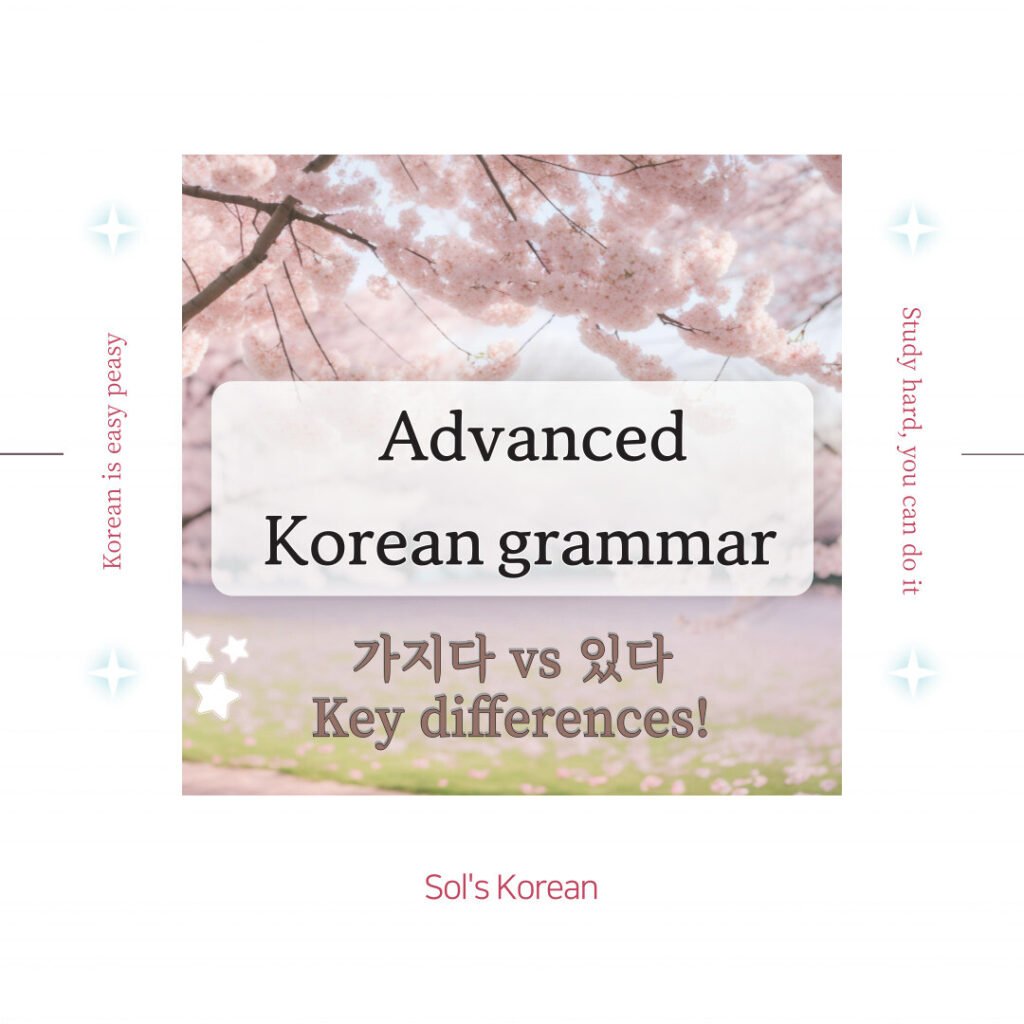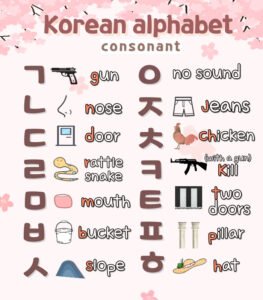가지다 vs 있다, What is the difference?
When you look up 가지다 vs 있다, they both translate to “to have” in English. But, as a Korean speaker, I can tell you there are clear differences between the two verbs.
Let’s explore each one and break down the key distinctions!
The verb 가지다 in Korean means “to have” or “to possess.” It emphasizes the act of owning, holding, or carrying something. On the other hand, 있다 also means “to have” but is more neutral and commonly used to indicate the existence or presence of something!
1. Expressing possession of objects:
- 가지다: Emphasizes the act of possessing or carrying something.
- 돈을 가지고 있어요.
(I have money on me. – Suggests you are carrying it physically 💵) - 우산을 가지고 가세요.
(Take an umbrella with you.) - 물병을 가지고 다니세요.
(Carry a water bottle with you.) - 그는 서류를 가지고 회의에 갔어요.
(He took the documents to the meeting.)
- 돈을 가지고 있어요.
- 있다: Neutral expression of possession or existence.
- 돈이 있어요.
(I have money. – Does not specify where the money is.) - 우산이 있어요.
(I have an umbrella.) - 물병이 있어요.
(I have a water botte. There is a water bottle.)
- 돈이 있어요.
2. Abstract ideas or emotions:
- 가지다: Used when talking about possessing abstract qualities or emotions, often in a formal tone.
- 자신감을 가지세요.
(Have confidence.) - 희망을 가지고 살아가요.
(Live with hope.) - 긍정적인 태도를 가지세요.
(Have a positive attitude.)
- 자신감을 가지세요.
- 있다: Neutral existence of abstract concepts.
- 자신감이 있어요.
(I have confidence.) - 희망이 있어요.
(There is hope.) - 취미가 있어요.
(I have hobbies.)
- 자신감이 있어요.
Key differences:
To say ‘I want to have a happy family,’ we should use only ‘가지다,’ and here’s why:
- 행복한 가정을 가지고 싶어요
(I want to have a happy family.)
-> 가지다 (to have) is used here because you’re expressing the desire to actively have something, in this case, a happy family. 가지다 captures the idea of actively possessing or wanting something. - 행복한 가정이 있고 싶어요
-> Using 있어요 sounds unnatural. This is because 있다 (to exist) is typically used for more neutral, factual expressions of existence or presence, and it doesn’t work well with 싶어요 (want) in this context. - 행복한 가정이 있어요
(There is a happy family.)
-> 있다 (to exist) is more about stating the presence of something. Saying 행복한 가정을 있어요 would mean that a happy family exists, but it wouldn’t make sense with 싶어요, which indicates a desire. You wouldn’t say, “I want that a happy family exists.”
We also often use 가지다 with -고 있어요 (be – ing)!
가지고 있어요: currently having/owning/possessing something.
(1)
1. 목표를 가지고 있어요 (I have a goal.)
Here, 가지다 (to have) + 있다 is used, which again emphasizes the active possession or holding of a goal. It suggests that you not only have a goal but are actively pursuing or embodying it.
2. 목표가 있어요 (I have a goal.)
This is a more neutral expression, simply stating the existence of a goal. It doesn’t carry the same emphasis on actively holding or possessing it, just that the goal is there.
(2)
1. 차 여러 대 가지고 있어요 (I have several cars.)
This construction suggests that you actively own or hold several cars, making the ownership more personal or intentional.
2. 차 여러 대 있어요 (I have several cars.)
This expression is more neutral and factual, just indicating that you have several cars, without any added nuance about the act of owning them.
We also use “가지고” + verb forms. The most commonly used ones are:
가지고 다니다 / 가지고 살다.
1. 가지고 다니다 (to carry around, to take with you)
This expression is used when you are carrying something with you!
- 휴대폰을 항상 가지고 다녀요.
(I always carry my phone around.) - 혹시 몰라서 현금을 항상 가지고 다녀요.
(I always carry cash with me just in case.)
2. 가지고 살다 (to live with, to live while having something)
This expression is used when you are living with or continuing to live while possessing a certain thing, attitude, or quality.
- 자신감을 가지고 살아야 해요.
(You have to live with confidence.) - 항상 겸손한 태도를 가지고 살려고 해요.
(I try to live with a humble attitude.)








